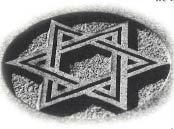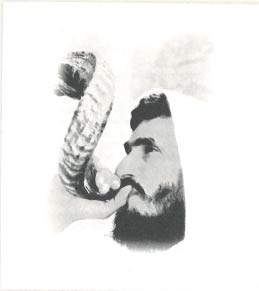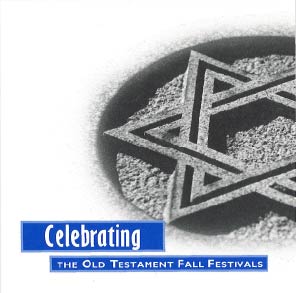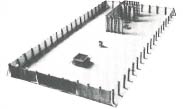Updated March, 2025
Throughout the Old Testament, God commands his people to observe special holidays. Chief among them are three fall and three spring festivals. The fall festivals were all celebrated in the same Jewish month of Tishri; the equivalent of our September/October:
Rosh Hashanah—the Feast of Trumpets (New Year’s Day)
Yom Kippur—the Day of Atonement
Sukkoth—the Feast of Booths
The three spring festivals are
Purim—the celebration of deliverance from Haman’s plot to kill the Jews
Passover—the celebration of the deliverance from Egypt
Pentecost—The Feast of Weeks, of the Harvest
This article offers suggestions for celebrating the fall festivals in worship; ideas for the spring festivals will appear in RW 63 (March 2002).

Why Celebrate Festivals in Worship?
How can New Testament Christians benefit from celebrating Old Testament festivals? We discovered three benefits that made these services worthwhile.
- First, our congregation is better able to understand the context of God’s mighty acts. Our immersion in Old Testament ways of celebrating helped us understand a big part of our Bibles of which we were previously unaware. The much-loved rubric of “promise and fulfillment” is made richer when we celebrate the promises as God revealed them and intentionally point to their fulfillment in Christ.
- Second, these services illustrated how God has provided for children throughout history and helped us focus on ways of keeping covenant with younger generations. We gained a renewed appreciation of our obligation to celebrate the high Christian holidays in child-friendly ways that teach little ones the mighty acts of God. These services have given new impetus to us as church leaders to be thinking about ways the Christian holidays, including the neglected holidays of Ascension Day and Pentecost, can be reclaimed. We have also come to see that symbols and traditions that detract from the real story of the day (such as secular symbols that encroach on Christmas and Easter) should be purged without remorse.
- Most important, these services helped us worship and bring glory to God. The original festivals (and our services) were designed to show all generations God’s amazing cosmic plan to redeem creation and restore what was broken at the fall. The festivals and our worship have drawn all of us who have ears to hear and eyes to see to a renewed awareness that God loved the world, and did so with such a fierce, stubborn, and unrelenting love, that God’s only Son came into the world so that we might be saved and not condemned.

Rosh Hashanah—The Feast of Trumpets
Scripture: Leviticus 23:23-25; Revelation 3:1-6
Call to Confession: Revelation 3:1-3
Assurance of Pardon: Revelation 3:5-6
Song Suggestions
“Alleluia! Sing to Jesus”Dix
“Day of Judgment! Day of Wonders!”Newton
“Praise the Lord with the Sound of Trumpet”Sleeth
“Rejoice, the Lord Is King”Wesley
“Shine, Jesus Shine”Kendrick
“Shout to the Lord"Zschech
“Sing a New Song”
“Stay Awake, Be Ready” Walker
“Step by Step”Beaker
“Trumpet the Name! Praise Be to Our Lord!”Seerveld
Affirmation of Faith
We long for that day
when Jesus will return as triumphant king,
when the dead will be raised
and all people will stand before his judgment.
We face that day without fear,
for the Judge is our Savior.
Our daily lives of service aim for the moment when
the Son will present his people to the Father.
Then God will be shown to be true, holy, and gracious.
All who have been on the Lord’s side will be honored,
the fruit of even small acts of
obedience will be displayed;
but tyrants and oppressors,
heretics, and all who deny the Lord
will be damned.
—Our World Belongs to God, stanza 57
Sermon Notes
Rosh Hashanah is New Year’s Day in the Jewish calendar. It is observed on the first and second day of Tishri, which is the seventh month of the Jewish calendar (in September or October). Rosh Hashanah is not a festive time like our New Year’s celebration. It is the first of the “Ten Days of Awe” that lead up to the Day of Atonement (Yom Kippur). The ten days between Rosh Hashanah and Yom Kippur are the most solemn days of the Jewish year. No one ever gets married during those days. No birthdays are celebrated during this period. They are days of penitence, fasting, and sorrow for sin.
Why does the Jewish New Year fall on the seventh month of the Jewish calendar instead of the first? Rosh Hashanah is the anniversary of the day when God completed the work of creation and judged it “very good.” Traditionally, this first day of the seventh month also marks the day God takes stock of creation, judging the actions of God’s people.
So Rosh Hashanah is both a festival of celebration of the beginning of the world and also a time of utmost seriousness.
According to one part of Jewish tradition, it is on Rosh Hashanah that God records people’s names in the Book of Life. So as they leave the synagogue after Rosh Hashanah services, people say to each other, “May your name be written in the Book of Life.” (We encouraged everyone to say this greeting to each other at the end of the service.)
The traditions of Rosh Hashanah are simple, as the only commandment specified in the Bible for the holiday is the blowing of the shofar: “On the first day of the seventh month you are to have a day of rest, a sacred assembly commemorated with shofar blasts” (Lev. 23:24). Whoever blows the shofar needs a powerful set of lungs. There are really four blasts. As each trumpet blast was described or referred to in the service and the sermon, we played the appropriate sound of the shofar (see box below).
- Tekiah: One positive, hopeful blast, used to assemble the people and to signal the coronation of a king. In worship the Tekiah symbolizes the kingship and sovereignty of God. (We used this sound at the call to worship.)
- Teruah: Staccato and anxious, this blast is meant to sound the alarm. It is what a watchman on the walls would trumpet when an approaching enemy was sighted. In worship the Teruah is the call to confess and to repent of your sins, for God is judging the earth. “May your name be written . . .”
- Shevarim: Three broken blasts. Shevar means to break, to smash. It is closely associated with the wrath of God. It too is an anxious sound, and in worship it is used when the Torah is read. Many commentators believe the Shevarim will be the sound of the trumpet at the second coming of the Lord Jesus Christ.
- Tekiah Gedolah: A long, haunting and mournful blast. When an expert shofar blower blows the Tekiah Gedolah, it sends shivers up the spine of listeners, for it speaks to deep and restless things in the soul. Many commentators believe this was the sound that Joshua and the priests used while marching around the city of Jericho.
Another Rosh Hashanah tradition incorporated into this service was a recitation of the role of the shofar in the Scriptures. We examined some of the following points:
- Why is the shofar a ram’s horn? Why not a cow’s horn or a brass horn? We first meet a ram’s horn in the book of Genesis when Abraham has taken his only son, whom he loves, up on the mountain to sacrifice him before the Lord. God spares the boy, the one on whom God’s promise to save the world depends; in his place God supplies a ram that is caught by its horns in a thicket. The shofar reminds God and God’s people of the promise to spare the people and make of them a great nation.
- The next time we hear the blast of the shofar is at Mount Sinai. Here it must have been God blowing the trumpet—the sound is so huge that everyone trembles and is afraid (Ex. 19:16, 19; 20:18). In this case the sound of the shofar is so startling and appalling that it is the very voice of God. Tradition has it that the blast heard on Mount Sinai was the Shevarim.
- After the wandering in the wilderness, the children of Israel entered the promised land and began capturing and taking over that land. During this period, the shofar plays a prominent role as a battle cry (Josh. 6:15-21; Judg. 7:17-22).
- After Israel had settled in the land and enjoyed prosperity and prominence, they started to forget who had won the battles for them. Now the trumpet blast becomes a blast of warning and then of dread and of judgment: the Shevarim (Jer. 4:19; 6: 17-19).
- During the time of captivity and later on during the restoration, the shofar sounded again with alarm, but this time because of the coming of the great day of the Lord (Zeph. 3:14-17).
- Jesus takes up that theme of warning and alarm when he speaks about the signs of the coming of the Son of Man (Matt. 24:29-31).
- Paul too speaks of the day of the Lord and the trumpet (1 Cor. 15:51-52; 1 Thess. 4:16-18). These blasts are clearly the Tekiah, the ringing triumphal blasts of the coronation of a king.
- Lastly, in the book of Revelation the seventh angel blows the seventh trumpet that completes the great plan of salvation (Rev. 10:7; 11:15-19).
The sermon concluded with a reminder of Christ’s appearing again at the great sound of the trumpet, and the question with which we began: Is your name written in the Book of Life?

Celebrating the Old Testament Fall Festivals
Yom Kippur—Day of Atonement
Call to Worship: Zephaniah 3:14-17
Scripture: Hebrews 9:1-10; Hebrews 9:11-10:4, 11-18; Hebrews 10:19-25
Song Suggestions
“Come, You Disconsolate”Moore
“Create in Me a Clean Heart”Anonymous
“Hail, O Once-Despised Jesus”Bakewell
“Have We Any Gift Worth Giving”Daw
“I Offer My Life” Cloninger, Moen
“May the Lord Bless You”
“My Faith Looks up to Thee”Palmer
“Now Behold the Lamb”Franklin
“Praise God’s Name”VanAndel Frisch
“Savior of the Nations, Come” Ambrose, Luther
“See, Christ Was Wounded for Our Sake”Foley
“Since Our Great High Priest, Christ Jesus”Idle
“There Is a Redeemer”Green
Assurance of Pardon
Yom Kippur is also known as “face-to-face” day because through atonement, sinners can come face-to-face with God. The following Assurance of Pardon visually demonstrates that concept.
[Readers begin with their backs toward the congregation. Before reading lines (or reciting them from memory), each person turns to face congregation.]
Reader 1: While justly angry, God did not turn his back on a world bent on destruction;
Reader 2: He turned his face to it in love.
Reader 3: With patience and tender care, he set out on the long road of redemption to reclaim the lost as his people and the world as his kingdom.
—Our World Belongs to God, stanza 19
Sermon Notes
To emphasize the movement from somberness and guilt to joy, we broke the sermon into three meditations interspersed with Scripture readings and songs, each carrying through one of those themes. Because gratitude and joy flow from the final meditation, the congregational prayer (we can approach God’s throne in confidence; Heb. 10:19, 22) and the offering (we spur one another on toward love and good deeds; Heb. 10:24) were natural responses. We urged the congregation to fast from sundown Saturday night through the time of the service.
Meditation 1: Troubling Shadows
Scripture: Hebrews 9:1-10
Unlike most of the feast and festival days that God gave the children of Israel, Yom Kippur is a day of fasting and of confession of sin. In tone and mood of celebration, it is like our Good Friday, only much more so. It is observed ten days after Rosh Hashanah, the Jewish New Year (Lev. 16:30-31). Hebrews 9:1-10 looks back on the solemn observation of the Day of Atonement.
- In the Old Testament preaching was a dangerous job; it fell to priests to stand in the gap between the holy God and the stained and defiled people. Priests entered into the Holy Place and the Most Holy Place in the tabernacle. They trod on ground that others dared not. When the Lord God spoke to Moses after the death of the two sons of Aaron, who died when they approached the Lord (Lev. 16:2), he said, “Don’t go there, lest you die.” When the high priests went into the Most Holy Place, they had a rope tied around their ankles so that they could safely be pulled out in case they were struck down.
- You may want to recount the fourteen steps of all that must occur on the Day of Atonement. (These steps are clearly outlined in the NIV Study Bible notes on Leviticus 1:1-34.)
Why such an elaborate process? Why so much trouble? Why so all-fired serious? These were shadows—troubling shadows that foretold a lot more trouble that was to come (Heb 9:9-10).
- This elaborate and solemn ritual pointed out the desperate seriousness of the sins of the people. It was intended to help them understand what it would cost finally to deliver them from their sins. The ritual pointed to the Messiah, the final High Priest, the final scapegoat who was coming into the world.
Meditation 2: Humbling Realities
Scripture: Hebrews 9:11-10:4, 11-18
- Most people, especially children, love animals. It is hard to think of all of those animals being killed for religious purposes. Jesus is the Lamb of God, the one who was finally able to truly and effectively take away, by his blood, the sins of the world. Now goats and lambs and calves no longer need to be sacrificed for us because Jesus was.
- The first thing Jewish people eat after fasting for Yom Kippur is kreplach, which is made of meat inside a pocket of pastry dough. Meat in Jewish history symbolized God’s judgment on sinfulness. Something has to die; the wages of sin is death. But surrounding the meat is the “grace” of pastry. Grace is greater than sin. God’s mercy triumphs. Kreplach reminds us that Jesus, the perfect Lamb of God, had to die for our sin. And it reminds us that mercy overcomes


